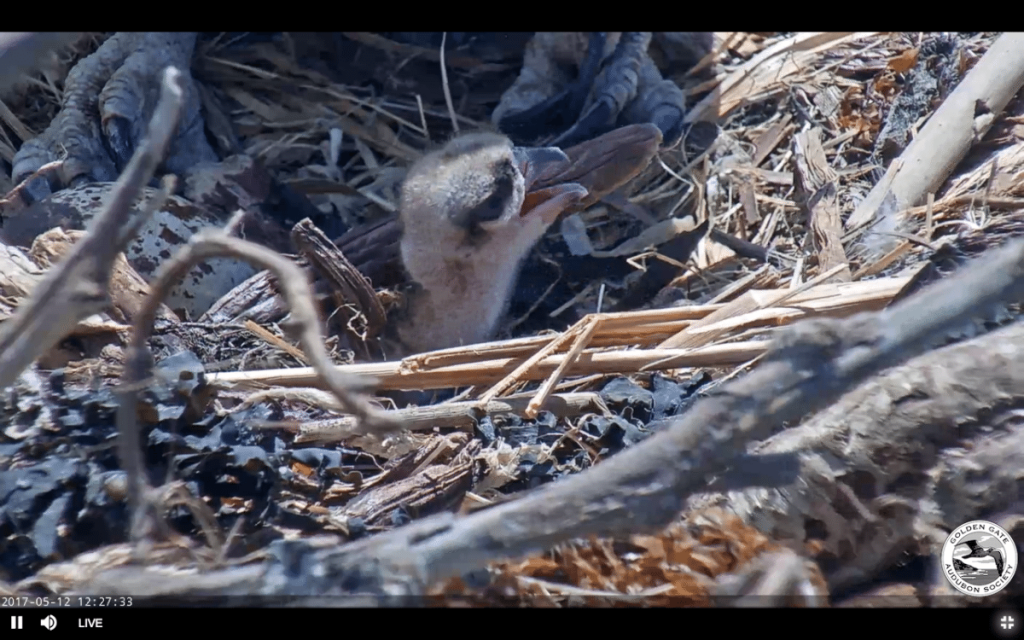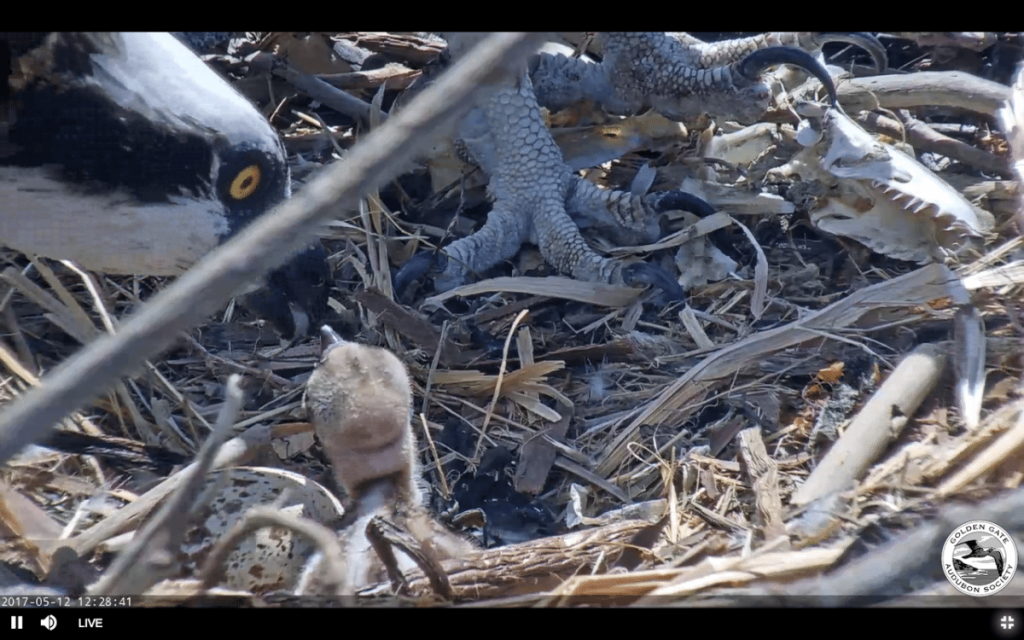Congratulations, it’s an Osprey chick!
By Ilana DeBare
Mother’s Day came early on top of the Whirley Crane — with the Osprey pair at the center of our live nest cam hatching their first chick early Friday morning!
Rosie, the mother, was on the nest in the early morning hours as the first of two eggs hatched over a period of about nine hours. When the chick had pecked its way partly out of the shell, she picked up the discarded top half of the shell and tossed it out of the nest.
What was at first only visible as a pink ball hidden deep with in the nest became a limp, squirmy creature… and then an active chick, holding up its head and begging for food. Richmond, the father, flew in with a fish and took part in the first feeding.
Here’s a video clip of the family shortly after hatching:
https://youtu.be/nS1r2jT1m0E
And here are two photos of the chick during its first feeding, around 12:30 p.m. on Friday:


Golden Gate Bird Alliance launched the live nest cam of the Osprey nest at the end of March. Since then, over 24,000 have visited the nest cam web site at sfbayospreys.org to watch the pair incubate their eggs and prepare to raise a family.
Rosie and Richmond’s first egg was laid on April 1st. Rosie initially laid three eggs, but she removed one from the nest on May 1 after it developed a crack and was no longer viable.
The young Ospreys will spend 50 to 55 days in the nest before they fledge. Both parents will take turns feeding them and attending the nest to warm the chicks and protect them from predators such as eagles and ravens. The biggest potential threats to nestling Ospreys are predation, exposure, and lack of food.
“Rosie and Richmond so far have been terrific parents,” said Cindy Margulis, Executive Director of Golden gate Audubon “They kept the eggs consistently covered and warm, fought off interloping birds, and rebuilt part of the nest when it was damaged during heavy winds. We’re hoping they will be just as good a team when it comes to feeding and tending their chicks.”
While a successful hatch of Osprey eggs may seem routine, that has not always been the case. In the 1960s and 70s, Osprey populations plummeted and the species was threatened with extinction when the pesticide DDT made Osprey egg shells so thin that they broke during incubation.
It was thanks to the federal government’s ban on DDT that Ospreys were able to resume hatching young successfully. And it’s thanks to government clean water regulations and continuing Bay restoration work by many agencies and nonprofits that San Francisco Bay today supports the fish populations that Ospreys need to survive.
“Bay Area Ospreys are an inspiring example of an environmental success story,” Margulis said. “Instead of vanishing, they’ve actually expanded their nesting range to San Francisco Bay. They started nesting along the Bay for the very first time in the early 2000s, and last year we had 42 nesting pairs that produced 51 new fledglings. Rosie and Richmond’s chicks are part of this Osprey baby boom!”
The Osprey nest cam web site contains more than just a live video stream. It also offers information on how we can help Ospreys thrive, downloadable lesson plans for teachers of grades 6-12, and live chat about the Ospreys. The live chat section of the web site has become a friendly and busy online community with participants sharing Osprey observations, screen shots, and humor, and answering questions from newcomers to the site.
With all the avian family drama, there is indeed humor — like one incident where Richmond brought a discarded baseball cap to the nest. Rosie did not feel it was suitable home decor, flew it out of the nest, and dumped it in the Bay. You can watch that domestic interlude including her disposal of the offensive hat here below. Then check out that live feed and join the chat at sfbayospreys.org!
